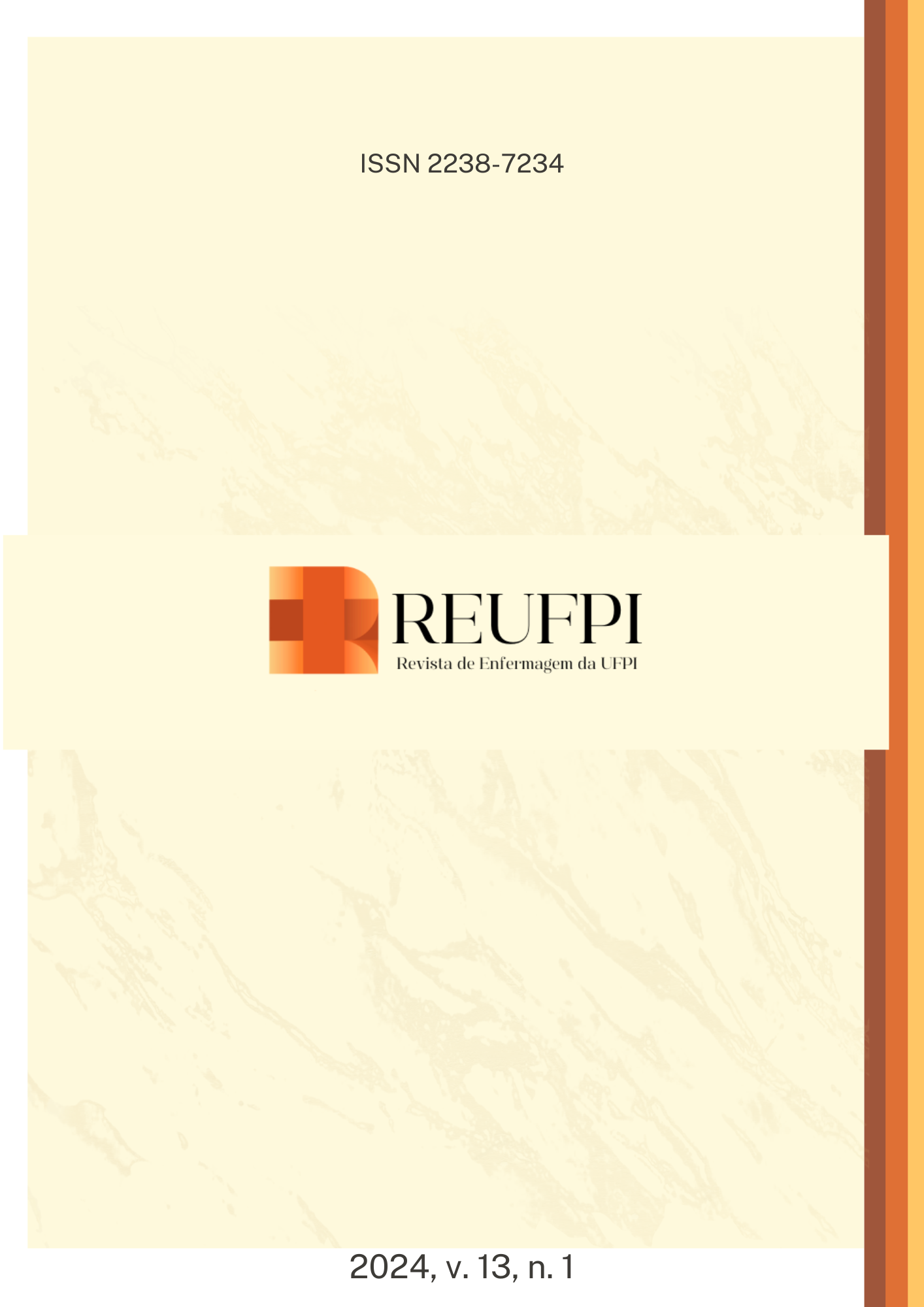Hospital-based registries of women with breast cancer from the oncology network of Espírito Santo, Brazil
DOI:
https://doi.org/10.26694/reufpi.v13i1.5562Palavras-chave:
Oncology, Breast Neoplasms, Epidemiology, Public Health, Women's HealthResumo
Objective: To describe the cases of women with breast cancer (BC) and identify the epidemiological profile of the cases reported in the Hospital-based Cancer Registries (HCR) of the Oncological Care Network of Espírito Santo (OCN/ES). Methods: This is a hospital-based descriptive observational study, based on secondary data retrieved via the HCR Tumor Registration Form of the eight hospitals that comprising the OCN/ES, between 2000-2020. Results: There were 16,844 case records of women with breast cancer in this historical series. The median age of the women was 52 years. The age group with the highest number of cases (54.0%) was 41-60 years, 57.42% were brown, 51.70% married, and 30.80% had incomplete elementary school, residents of the Metropolitan region of the state (81.70%). Most cases were analytical (75.42%), referred from SUS (59.70%), had no occurrence of more than one primary tumor (94.21%), the most common histological type was infiltrating duct carcinoma (76.03%), and stage II (6.75%), with multimodal treatments (60.09%). Conclusion: The findings point to an increasing trend in the occurrence of breast cancer over the years in OCN/ES, occurring mainly in older, brown women and women with low education, in stage II of the disease.
Referências
Siegel RL, Miller KD, Wagle NS, Jemal A. Cancer statistics, 2023. CA Cancer J Clin. 2023 Jan;73(1):17-48. DOI: 10.3322/caac.21763.
Pan American Health Organization (PAHO). Noncommunicable diseases. Washington; 2021 [access in Dec 2023]. Disponível em: https://www.paho.org/en/topics/noncommunicable-diseases
Sung H, Ferlay J, Siegel RL, et al. Global Cancer Statistics 2020: GLOBOCAN estimates of incidence and mortality worldwide for 36 cancers in 185 countries. CA Cancer J Clin. 2021; 71:209–49. DOI: 10.3322/caac.21660.
Santos MO, Lima FCS, Martins LFL, Oliveira JFP, Almeida LM, Cancela MC. Estimativa de Incidência de Câncer no Brasil, 2023-2025. Rev. Bras. Cancerol. 2023;69(1):e-213700. Disponível em: https://rbc.inca.gov.br/index.php/revista/article/view/3700
Anderson KN, Schwab RB, Martinez ME. Reproductive risk factors and breast cancer subtypes: a review of the literature. Breast Cancer Res Treat. 2014 Feb;144(1):1-10. DOI: 10.1007/s10549-014-2852-7.
Yanez RJV, Fernandes AFC, Corpes EF, Castro RCMB, Sixsmith J, Lopes-Júnior LC. Palliative care in the treatment of women with breast cancer: A scoping review. Palliat Support Care. 2023 Dec 7:1-18. DOI: 10.1017/S1478951523001840.
Lopes-Júnior LC. Personalized Nursing Care in Precision-Medicine Era. SAGE Open Nurs. 2021 Dec 9;7:23779608211064713. DOI: 10.1177/23779608211064713.
Lopes-Júnior LC, Dell'Antonio LS, Pessanha RM, Dell'Antonio CS, Silva MI, Souza TM, Grassi J. Completeness and Consistency of Epidemiological Variables from Hospital-Based Cancer Registries in a Brazilian State. Int J Environ Res Public Health. 2022 Sep 22;19(19):12003.
Grippa WR, Dell'Antonio LS, Salaroli LB, Lopes-Júnior LC. Incompleteness trends of epidemiological variables in a Brazilian high complexity cancer registry: An ecological time series study. Medicine (Baltimore). 2023 Aug 4;102(31):e34369. DOI: 10.1097/MD.0000000000034369.
Brasil. Instituto Nacional de Câncer. Registros Hospitalares de Câncer: Planejamento e Gestão/Instituto Nacional de Câncer, 2ª ed.; INCA: Rio de Janeiro, Brasil, 2010; 536p. Disponível em: https://www.inca.gov.br/sites/ufu.sti.inca.local/files/media/document/registros-hospitalares-de-cancer-2010.pdf.
Ward E, Jemal A, Cokkinides V, Singh GK, Cardinez C, Ghafoor A, Thun M. Cancer disparities by race/ethnicity and socioeconomic status. CA Cancer J Clin. 2004 Mar-Apr;54(2):78-93. DOI: 10.3322/canjclin.54.2.78. PMID: 15061598.
Bach PB, Schrag D, Brawley OW, Galaznik A, Yakren S, Begg CB. Survival of blacks and whites after a cancer diagnosis. JAMA. 2002 Apr 24;287(16):2106-13. DOI: 10.1001/jama.287.16.2106.
Nunes RD, Martins E, Freitas-Junior R, Curado MP, Freitas NM, Oliveira JC. Descriptive study of breast cancer cases in Goiânia between 1989 and 2003. Rev Col Bras Cir. 2011 Jul-Aug;38(4):212-6. DOI: 10.1590/s0100-69912011000400002.
Hou N, Huo D. A trend analysis of breast cancer incidence rates in the United States from 2000 to 2009 shows a recent increase. Breast Cancer Res Treat. 2013 Apr;138(2):633-41. DOI: 10.1007/s10549-013-2434-0.
Destounis S, Santacroce A. Age to Begin and Intervals for Breast Cancer Screening: Balancing Benefits and Harms. AJR Am J Roentgenol. 2018 Feb;210(2):279-84. DOI: 10.2214/AJR.17.18730.
Coldman A, Phillips N, Wilson C, Decker K, Chiarelli AM, Brisson J, Zhang B, Payne J, Doyle G, Ahmad R. Pan-Canadian study of mammography screening and mortality from breast cancer. J Natl Cancer Inst. 2014 Oct 1;106(11): dju261. DOI: 10.1093/jnci/dju261.
Jiang R, Wang X, Sun Z, Wu S, Chen S, Cai H. Association of education level with the risk of female breast cancer: a prospective cohort study. BMC Womens Health. 2023 Mar 7;23(1):91. DOI: 10.1186/s12905-023-02245-y.
Larsen IK, Myklebust TÅ, Babigumira R, Vinberg E, Møller B, Ursin G. Education, income and risk of cancer: results from a Norwegian registry-based study. Acta Oncol. 2020 Nov;59(11):1300-7. DOI: 10.1080/0284186X.2020.1817548.
Lundqvist A, Andersson E, Ahlberg I, Nilbert M, Gerdtham U. Socioeconomic inequalities in breast cancer incidence and mortality in Europe-a systematic review and meta-analysis. Eur J Public Health. 2016 Oct;26(5):804-13. DOI: 10.1093/eurpub/ckw070.
Coughlin SS. Social determinants of breast cancer risk, stage, and survival. Breast Cancer Res Treat. 2019 Oct;177(3):537-48. DOI: 10.1007/s10549-019-05340-7
Xu LL, Gu KS. Clinical retrospective analysis of cases with multiple primary malignant neoplasms. Genet Mol Res. 2014 Mar 12;13(4):9271-84. DOI: 10.4238/2014.March.12.19.
Perkins CI, Hotes J, Kohler BA, Howe HL. Association between breast cancer laterality and tumor location, United States, 1994-1998. Cancer Causes Control. 2004 Sep;15(7):637-45. DOI: 10.1023/B: CACO.0000036171.44162.5f.
Al Saad S, Al Shenawi H, Almarabheh A, Al Shenawi N, Mohamed AI, Yaghan R. Is laterality in breast Cancer still worth studying? Local experience in Bahrain. BMC Cancer. 2022 Sep 10;22(1):968. DOI: 10.1186/s12885-022-10063-y.
Roychoudhuri R, Putcha V, Møller H. Cancer and laterality: a study of the five major paired organs (UK). Cancer Causes Control. 2006 Jun;17(5):655-62. DOI: 10.1007/s10552-005-0615-9.
Cheng SA, Liang LZ, Liang QL, Huang ZY, Peng XX, Hong XC, Luo XB, Yuan GL, Zhang HJ, Jiang L. Breast cancer laterality and molecular subtype likely share a common risk factor. Cancer Manag Res. 2018 Nov 29; 10:6549-54. DOI: 10.2147/CMAR.S182254.
Luo J, Xiao J, Yang Y, Chen G, Hu D, Zeng J. Strategies for five tumour markers in the screening and diagnosis of female breast cancer. Front Oncol. 2023 Jan 23; 12:1055855. DOI: 10.3389/fonc.2022.
Weigelt B, Geyer FC, Reis-Filho JS. Histological types of breast cancer: how special are they? Mol Oncol. 2010 Jun;4(3):192-208. DOI: 10.1016/j.molonc.2010.04.004.
Jagsi R, King TA, Lehman C, Morrow M, Harris JR, Burstein HJ. Chapter 79: Malignant Tumors of the Breast. In: DeVita VT, Lawrence TS, Lawrence TS, Rosenberg SA, eds. DeVita, Hellman, and Rosenberg’s Cancer: Principles and Practice of Oncology. 11th ed. Philadelphia, Pa: Lippincott Williams & Wilkins; 2019.
Reis APAM, Teixeira CMS, Medeiros ARL, Chaves KZC, Albuquerque CR, Melo MR. Sociodemographic and Clinical-pathological Study of Molecular Subtitles of Breast Carcinoma in a Reference Unit of Maranhão. Rev Bras Ginecol Obstet. 2020 Dec;42(12):820-8. DOI: 10.1055/s-0040-1719147.
Mutebi M, Anderson BO, Duggan C, Adebamowo C, Agarwal G, Ali Z, et al. Breast cancer treatment: A phased approach to implementation. Cancer. 2020 May 15;126 Suppl 10:2365-78. DOI: 10.1002/cncr.32910.
Bilani N, Zabor EC, Elson L, Elimimian EB, Nahleh Z. Breast Cancer in the United States: A Cross-Sectional Overview. J Cancer Epidemiol. 2020 Oct 30; 2020:6387378. DOI: 10.1155/2020/6387378.
Cardoso F, Costa A, Norton L, Senkus E, Aapro M, André F, et al. ESO-ESMO 2nd international consensus guidelines for advanced breast cancer (ABC2)†. Ann Oncol. 2014 Oct;25(10):1871-88. DOI: 10.1093/annonc/mdu385.
Sayed S, Moloo Z, Bird P, Wasike R, Njoroge W, Karanu J, et al. Breast cancer diagnosis in a resource poor environment through a collaborative multidisciplinary approach: the Kenyan experience. J Clin Pathol. 2013 Apr;66(4):307-11. DOI: 10.1136/jclinpath-2012-201404.
Fisher B, Anderson S, Bryant J, Margolese RG, Deutsch M, Fisher ER, Jeong JH, Wolmark N. Twenty-year follow-up of a randomized trial comparing total mastectomy, lumpectomy, and lumpectomy plus irradiation for the treatment of invasive breast cancer. N Engl J Med. 2002 Oct 17;347(16):1233-41. DOI: 10.1056/NEJMoa022152.
Braunstein LZ, Taghian AG, Niemierko A, Salama L, Capuco A, Bellon JR, et al. Breast-cancer subtype, age, and lymph node status as predictors of local recurrence following breast-conserving therapy. Breast Cancer Res Treat. 2017 Jan;161(1):173-9. DOI: 10.1007/s10549-016-4031-5.
Downloads
Publicado
Como Citar
Edição
Seção
Licença
Copyright (c) 2024 Rev Enferm UFPI

Este trabalho está licenciado sob uma licença Creative Commons Attribution 4.0 International License.
Autores mantém os direitos autorais e concedem à REUFPI o direito de primeira publicação, com o trabalho licenciado sob a Licença Creative Commons Attibution BY 4.0 que permite o compartilhamento do trabalho com reconhecimento da autoria e publicação inicial nesta revista.






